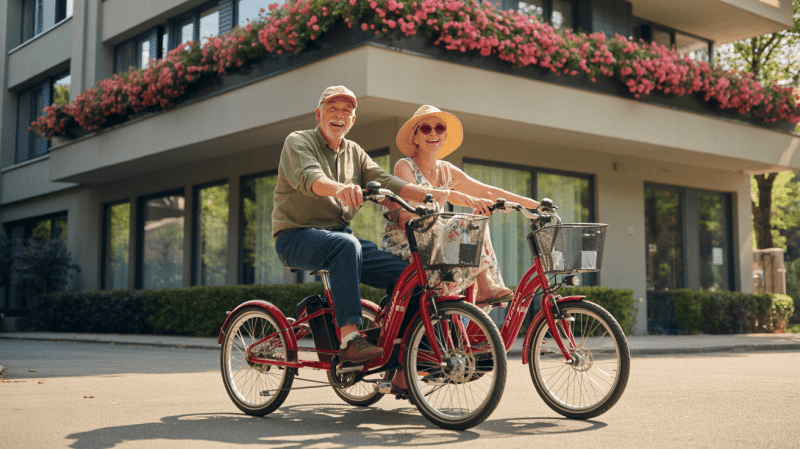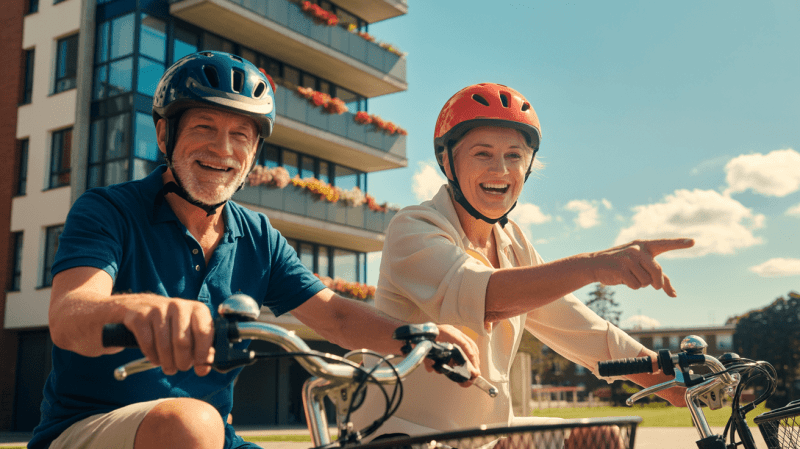"Ageless Adventures: Achievable Goals for Senior Cyclists Every Ride"
If you are a senior cyclist, it's important to set realistic and attainable fitness goals for your routine. While cycling is a fantastic way to stay active and healthy, it's crucial to consider your age and physical abilities when planning your workouts. By setting targets that suit your current fitness level, you can enjoy all the benefits of cycling while avoiding potential injuries or setbacks.
First and foremost, consult with your doctor or healthcare professional to ensure that cycling is safe for you. Once you have the green light, start by setting goals that take into account your age, experience, and overall health. It's important not to compare yourself to younger cyclists or feel pressured to meet their unrealistic expectations. Remember, your fitness journey is unique to you.
One effective way to set achievable targets is by focusing on incremental improvements. Break down your long-term goals into smaller, manageable milestones. For instance, aim to increase your cycling distance by a certain percentage each month or improve your average speed by a few kilometers per hour. Celebrating each mini-achievement will keep you motivated and make the process enjoyable.
Additionally, listen to your body and adjust your targets accordingly. Aging bodies may require more recovery time, so don't hesitate to schedule rest days and gentle cross-training exercises. Pay attention to joint pain or discomfort and modify your routine if needed. Always prioritize your safety and well-being over pushing yourself too hard.
By setting realistic and attainable fitness targets, you can make the most out of your senior cycling routine. Remember, each pedal stroke is a step towards improved health and well-being. So, hop on your bike, embrace the joy of cycling, and enjoy the ride!
Designing an Effective Cycling Regimen for Seniors
When it comes to staying active and healthy, cycling is an excellent option for seniors. Not only does it provide a low-impact cardiovascular exercise, but it also offers various physical and mental benefits. However, it is important to design a cycling regimen that is suitable for seniors, taking into consideration their fitness levels and potential limitations. By setting realistic goals and planning a routine that focuses on both enjoyment and safety, seniors can make the most out of their cycling experience.
To begin with, seniors need to listen to their bodies and start at a comfortable pace. Even if you were an avid cyclist in your younger days, it's important to acknowledge any changes in your physical abilities. Gradually build up your stamina and endurance by starting with shorter rides and gradually increasing the duration and intensity over time. Remember, it's not a race, and it's more important to maintain a steady and enjoyable pace that you can sustain without exerting excessive strain on your body.
Another crucial aspect of an effective cycling regimen for seniors is variety. Mixing up your cycling routes and terrains can help challenge different muscle groups, prevent monotony, and keep your mind engaged. Consider exploring local bike paths, parks, or scenic routes that offer a change of scenery. Additionally, incorporating strength training exercises specifically targeting the muscles used during cycling can enhance your overall cycling performance and minimize the risk of injuries.
Lastly, make sure you prioritize safety during your cycling routine. Invest in a well-fitting helmet, high-visibility clothing, and appropriate protective gear to ensure your safety on the road. It's also important to be aware of traffic rules and follow them diligently. If you're cycling in a group, communication and coordination are key, so practice hand signals and proper etiquette. Lastly, listen to your body and take rest days when needed to avoid overexertion.
Maximizing Results: Stay Motivated with Realistic Goals
Setting goals is an integral part of any successful senior cycling routine. Whether you're a beginner or an experienced rider, having realistic goals will help you stay motivated and achieve optimal results. Setting attainable goals ensures progress and prevents frustration.
When it comes to senior cycling, it's important to prioritize safety and health above all. Start by consulting your healthcare provider to determine the intensity and duration that's suitable for you. With their guidance, set realistic goals that align with your physical capabilities. Remember, it's not about how fast or how far you can ride but about building endurance and improving your overall fitness.
Breaking down your goals into smaller milestones can provide a sense of accomplishment along the way, making it easier to stay motivated. Gradually increase the difficulty and duration of your rides to challenge yourself without overexerting. For instance, if your initial goal is to cycle for 10 minutes without stopping, aim to gradually extend that to 15 or 20 minutes. These incremental steps allow for steady progress and increase your chances of success.
Finally, remember to celebrate your achievements, no matter how small they may seem. Acknowledging your progress is vital for staying motivated on your senior cycling journey. Reward yourself with a treat or share your accomplishments with supportive friends and family. Embrace the joy of achieving the goals you've set for yourself, and let that fuel your ambition for even greater triumphs on the road ahead.
Unlocking the Benefits of Senior Cycling: Goal-Oriented Approach
Senior cycling is not only a great source of fun and exercise, but also an effective way to achieve realistic goals for your routine. Whether you are a beginner or have been cycling for years, setting clear goals can help you stay motivated and make the most out of your cycling experience.
When it comes to senior cycling, goal-setting should be approached with a realistic mindset. It’s important to set achievable goals that align with your current fitness level and overall health. Maybe your goal is to increase the duration of your rides gradually or to conquer a specific distance milestone. By setting realistic goals, you will be able to track your progress more effectively and avoid potential setbacks or injuries.
Furthermore, a goal-oriented approach to senior cycling can lead to numerous benefits. Regular cycling can help improve cardiovascular health, strengthen muscles, and increase flexibility. It is also a low-impact exercise that puts less stress on joints, which can be especially beneficial for seniors. Moreover, achieving your cycling goals can boost your confidence, improve your mental well-being, and provide a sense of accomplishment.
DISCLAIMER
This document is provided for general information purposes only and should not be relied upon as providing legal advice, technical, or specific operational guidance to the reader, whether as to the practices described in the document or the applicable legal requirements and regulations.SeniorTrikes.Com expressly disclaims any responsibility for liability arising from or related to the use or misuse of any information in this document.
Recent Featured Articles:
"Seniors on the Move: A VIRIBUS Electric Trike Review"
Rediscovering Freedom: Embrace Senior Cycling in Retirement
Ultimate Guide to Senior-Friendly Electric Tricycles



